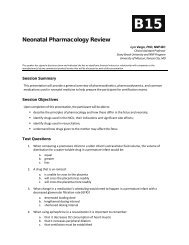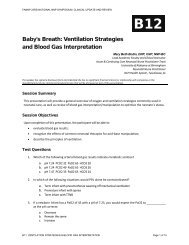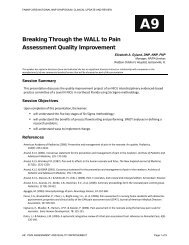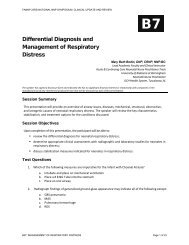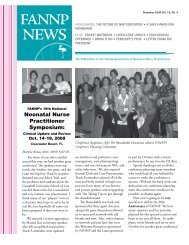Out for Blood: Neonatal Hematology Review - FANNP
Out for Blood: Neonatal Hematology Review - FANNP
Out for Blood: Neonatal Hematology Review - FANNP
Create successful ePaper yourself
Turn your PDF publications into a flip-book with our unique Google optimized e-Paper software.
<strong>FANNP</strong> 23RD NATIONAL NNP SYMPOSIUM: CLINICAL UPDATE AND REVIEWA Measure of it all…<strong>Blood</strong> VolumeA measure of it all…<strong>Blood</strong> Volume◦ Measured in ml/kg of body weight◦ Volume factors• Gestational age◦ Term: ~80-100 ml/kg◦ Preterm: ~90-105 ml/kg• Placental transfusion◦ Timing of cord clamping, infant positionrelated to placenta (above or below), uterinecontractions, cord compression, onset ofrespirations and decrease in PVR• Maternalfetal or Fetalmaternal transfusion• Twin-twin transfusion• Placenta previa or abruptio placentae• Nuchal cord• Iatrogenic lossA Measure of it all…<strong>Blood</strong> Volume◦ So why is keeping track of blood volumelosses so important?◦ SCENARIO• 2 kg 35 week infant with RDS & pneumonia onthe vent with ABGs every 6 hours & daily labdraws◦ What was the estimated beginning bloodvolume?• 180 ml• On DOL 3 the flow sheet says that the baby isout 15 ml of blood…◦ What % of the beginning blood volume is thebaby out?• 8%...yikes! And that’s if everyone has beenkeeping track accurately…AnemiaWhere did all my volume go?!?Anemia◦ Definition• Central venous Hgb of < 13 g/dL or capillaryHgb of < 14.5 g/dL◦ Oxygen carrying capacity & level ofoxygen available to the tissues reducedby…• Low Hgb concentration• Decreased # of RBCs◦ Etiology• Hemorrhage• Hemolysis• Prematurity• IatrogenicAnemia – Causes of Hemorrhage◦ Twin-to-Twin• Monozygotic, monochorionic (single)placenta• 13%-33% of twin pregnancies• Hgb difference b/w twins > 5 g/dL• Often size discrepancy as well…> 20%difference with chronic hemorrhage◦ Larger Twin: recipient, polyhydramnios;at risk <strong>for</strong> congestive heart disease and/orsystemic/pulmonary hypertension due tovolume overload, hyperviscosity◦ Smaller Twin: donor, oligohydramnios; atrisk <strong>for</strong> anemia with elevated retic count,at risk <strong>for</strong> IUGR and high output cardiacfailure◦ High risk <strong>for</strong> long-term developmentaldelayB14: NEONATAL HEMATOLOGY REVIEW Page 6 of 22



